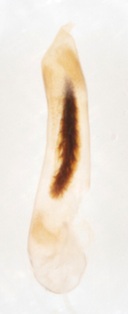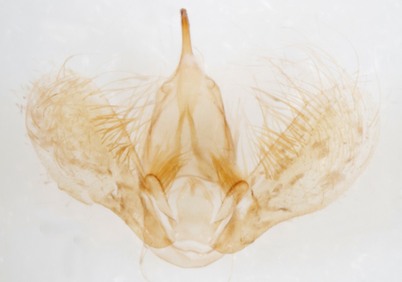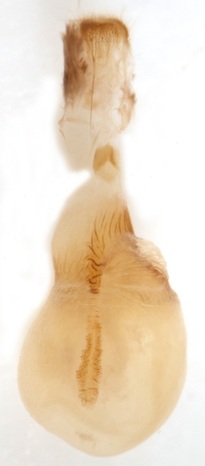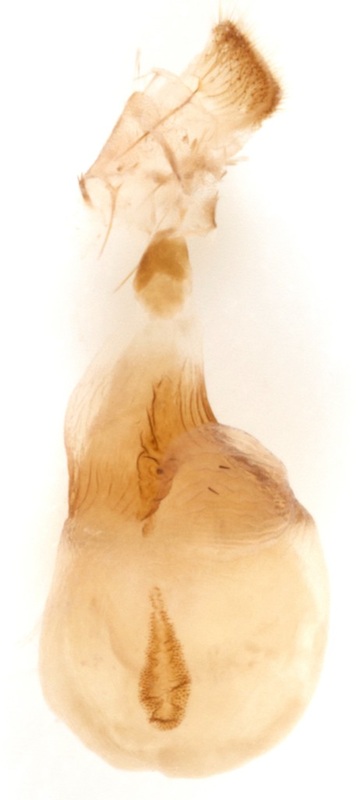Dysstroma |
D.truncata (Common Marbled Carpet) and D.citrata (Dark Marbled Carpet) are both very variable and very similar to each other.
Based on the references available to me (Waring and Townsend and the genital images at Moth Dissection), I have not been able to separate these species with confidence. During 2013/14 I have examined ~40 specimens and I am now happy that they are separable using the following features, which are illustrated in the galleries that follow:
1) Forewing median fascia has a 2-3-pointed projection from its distal margin - the projection is longer and its apices more pointed in D.citrata.
2) Hindwing median cross-line has a pointed ~90 degree angle* in D.citrata and a rounded obtuse angle in D.truncata - best seen on underside.
3) Male genitalia: cornutal bundle occupies ~1/2 diameter of aedeagus in D.truncata, ~3/4 in D.citrata; peripheral and central cornuti similar in D.truncata; peripheral cornuti much stronger than central cornuti in D.citrata.
4) Female genitalia: in D.truncata the sclerotisation of the ductus bursae (DB) is about as long as the diameter of the DB, while in D.citrata the sclerotisation is about twice as long as the diameter of the DB. The 'frill' of sclerotisation in the posterior portion of the corpus bursae has a transverse anterior border in D.truncata, while in D.citrata its anterior border is rounded. The corpus bursae is broader in D.truncata so that the signum occupies 1/6 to 1/8 of its transverse diameter, while that of D.citrata occupies 1/4 to 1/5.
* Waring and Townsend state and illustrate an acute angle for D.citrata - in my experience the angle is seldom more acute than 90 degrees (the requirement for it to be an acute angle has caused me much difficulty in separating these species up to now)
Based on the references available to me (Waring and Townsend and the genital images at Moth Dissection), I have not been able to separate these species with confidence. During 2013/14 I have examined ~40 specimens and I am now happy that they are separable using the following features, which are illustrated in the galleries that follow:
1) Forewing median fascia has a 2-3-pointed projection from its distal margin - the projection is longer and its apices more pointed in D.citrata.
2) Hindwing median cross-line has a pointed ~90 degree angle* in D.citrata and a rounded obtuse angle in D.truncata - best seen on underside.
3) Male genitalia: cornutal bundle occupies ~1/2 diameter of aedeagus in D.truncata, ~3/4 in D.citrata; peripheral and central cornuti similar in D.truncata; peripheral cornuti much stronger than central cornuti in D.citrata.
4) Female genitalia: in D.truncata the sclerotisation of the ductus bursae (DB) is about as long as the diameter of the DB, while in D.citrata the sclerotisation is about twice as long as the diameter of the DB. The 'frill' of sclerotisation in the posterior portion of the corpus bursae has a transverse anterior border in D.truncata, while in D.citrata its anterior border is rounded. The corpus bursae is broader in D.truncata so that the signum occupies 1/6 to 1/8 of its transverse diameter, while that of D.citrata occupies 1/4 to 1/5.
* Waring and Townsend state and illustrate an acute angle for D.citrata - in my experience the angle is seldom more acute than 90 degrees (the requirement for it to be an acute angle has caused me much difficulty in separating these species up to now)
Forewing
Hindwing
In my experience, cross-lines on the underside are more strongly marked in D.citrata and I have never seen the antemedian cross-line (which passes through the 'central' spot) well-developed in D.truncata.
In my experience, cross-lines on the underside are more strongly marked in D.citrata and I have never seen the antemedian cross-line (which passes through the 'central' spot) well-developed in D.truncata.
Male Genitalia
The only difference I can see is that the cornutal bundle appears narrower in the aedeagus of D.truncata. The extracted cornutal bundle of D.truncata consists of about 60 fairly evenly sized spines; that of D.citrata seems to be more variable in the number of spines, but is commonly also around 60, with stout spines around the periphery of the bundle and finer spines in the centre.
The only difference I can see is that the cornutal bundle appears narrower in the aedeagus of D.truncata. The extracted cornutal bundle of D.truncata consists of about 60 fairly evenly sized spines; that of D.citrata seems to be more variable in the number of spines, but is commonly also around 60, with stout spines around the periphery of the bundle and finer spines in the centre.
Female Genitalia
Both species are shown at Dissection Group. I have not seen any description of the differences between the species. It appears that in D.truncata the sclerotisation of the ductus bursae (DB) is about as long as the diameter of the DB, while in D.citrata the sclerotisation is about twice as long as the diameter of the DB. The 'frill' of scleorisation in the posterior portion of the corpus bursae has a transverse anterior border (like the hem of a dress) in D.truncata, while in D.citrata its anterior border is rounded (like the neck-line of a low-cut dress). The signum is fairly similar in both species but appears more squared off at the anterior end in D.truncata and slightly pointed in D.citrata. The corpus bursae seems to be broader in D.truncata so that the signum occupies 1/6 to 1/8 of its transverse diameter, while that of D.citrata occupies 1/4 to 1/5.
(Note that these features cannot all be seen in a single view and that the last feature would be unreliable if the corpus bursae was ruptured).
Both species are shown at Dissection Group. I have not seen any description of the differences between the species. It appears that in D.truncata the sclerotisation of the ductus bursae (DB) is about as long as the diameter of the DB, while in D.citrata the sclerotisation is about twice as long as the diameter of the DB. The 'frill' of scleorisation in the posterior portion of the corpus bursae has a transverse anterior border (like the hem of a dress) in D.truncata, while in D.citrata its anterior border is rounded (like the neck-line of a low-cut dress). The signum is fairly similar in both species but appears more squared off at the anterior end in D.truncata and slightly pointed in D.citrata. The corpus bursae seems to be broader in D.truncata so that the signum occupies 1/6 to 1/8 of its transverse diameter, while that of D.citrata occupies 1/4 to 1/5.
(Note that these features cannot all be seen in a single view and that the last feature would be unreliable if the corpus bursae was ruptured).








































